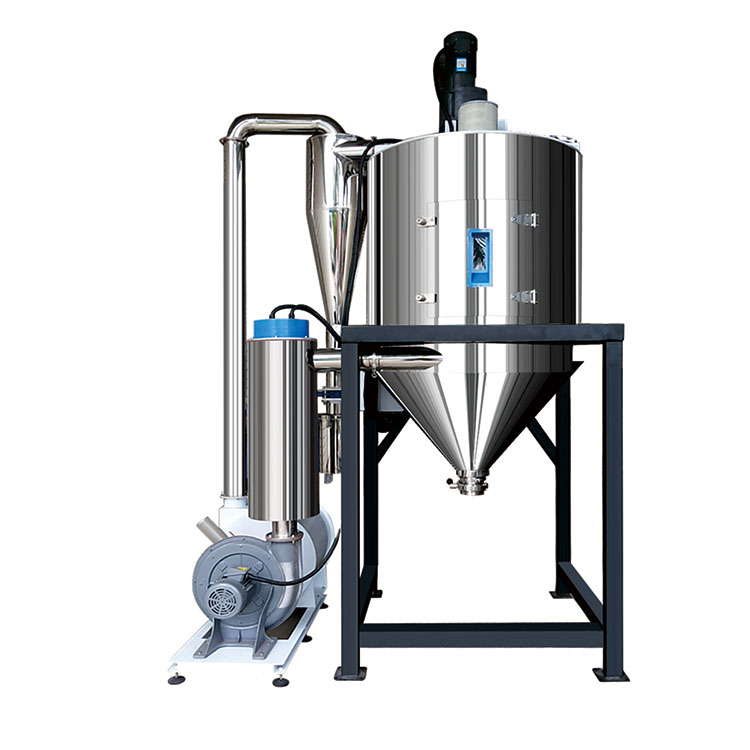- English
- Español
- Português
- русский
- Français
- 日本語
- Deutsch
- tiếng Việt
- Italiano
- Nederlands
- ภาษาไทย
- Polski
- 한국어
- Svenska
- magyar
- Malay
- বাংলা ভাষার
- Dansk
- Suomi
- हिन्दी
- Pilipino
- Türkçe
- Gaeilge
- العربية
- Indonesia
- Norsk
- تمل
- český
- ελληνικά
- український
- Javanese
- فارسی
- தமிழ்
- తెలుగు
- नेपाली
- Burmese
- български
- ລາວ
- Latine
- Қазақша
- Euskal
- Azərbaycan
- Slovenský jazyk
- Македонски
- Lietuvos
- Eesti Keel
- Română
- Slovenski
What is a dehumidifying dryer and how does it work?
2025-10-15
In many industries, such as plastics processing, electronics manufacturing, and food storage, humidity often poses a hidden threat to production and product quality. Excessive humidity can cause plastic raw materials to clump, bubbles to form in molded products, damage electronic components due to moisture, and food to mold and spoil, severely impacting production efficiency and product quality. Dehumidifying dryers, as key equipment for addressing humidity issues, are becoming an indispensable production tool across various industries. Today, we'll introduce high-quality dehumidifying dryers from Niasi Plastic, a professional Chinese manufacturer.
What is a dehumidifying dryer?
A dehumidifying dryer is a device specifically designed to remove excess moisture from air or materials, maintaining humidity within a reasonable range. Unlike conventional drying equipment, which relies on heating to evaporate moisture, dehumidification dryers achieve efficient dehumidification at lower temperatures through physical processes such as adsorption and condensation. This not only prevents material property changes caused by high temperatures but also significantly reduces energy consumption. Dehumidifying dryers are ideal for drying moisture-sensitive and heat-sensitive materials, such as plastic granules, chemical raw materials, and pharmaceutical intermediates. As a leading dehumidifier dryer manufacturer in China, Niasi Plastics has been deeply involved in the industry for many years, consistently striving to provide customers with efficient, energy-saving, and stable dehumidification and drying solutions. Leveraging advanced technological R&D capabilities and a rigorous quality control system, Niasi Plastics has become a trusted dehumidifier dryer supplier and factory for numerous companies worldwide. Whether small plastics processing shops or large multinational manufacturers, Niasi Plastics offers customized products and services tailored to their specific needs, helping them address moisture challenges and improve production efficiency.

How does a dehumidifier dryer work?
Understanding the workings of a dehumidifier dryer is essential for selecting the right equipment. Its operation is essentially an efficient "adsorption-regeneration" cycle, with the following key steps:
1. Pre-treatment & Closed-Loop System:
Ambient air first passes through a primary filter to remove dust and impurities.
It then enters a preheater where it is heated to a preset temperature (typically 40-180°C, adjustable depending on the material). Preheating is crucial; hot air can carry more moisture.
Key innovation: The entire system utilizes a closed-loop design! The dried hot air is repeatedly recycled to prevent the intrusion of external moisture, ensuring a stable and efficient drying environment.
The Core of Deep Drying: Molecular Sieve Adsorption
2. Deep Drying: Molecular Sieve Adsorption
The barrel is filled with high-performance molecular sieve (zeolite) adsorbents. These porous materials act like powerful "moisture magnets," their microporous structure possessing a high affinity for water molecules, firmly capturing moisture in the air.
After passing through the adsorption bed, the air is deeply dehumidified, resulting in extremely dry, low-dewpoint air (dew points can reach -40°C or even lower).
3. The Purpose of Dry Air: Material Drying
The high-temperature, dry air after deep dehumidifying is fed into the drying hopper.
The air penetrates the accumulated plastic pellets from bottom to top, absorbing moisture from within and on the surface of the pellets and carrying it out of the hopper.
This process requires precise control of air volume, temperature, and time to ensure uniform and thorough drying of the material.
4. Adsorbent Regeneration: Restoring "Magnetic Force" (Desiccant Regeneration):
When the molecular sieve in the dehumidifier barrel approaches saturation with water, its water-holding capacity drops dramatically.
The ingenious dual-tower design (or rotary valve) comes into play at this point: the system automatically switches to a standby dry barrel and simultaneously initiates regeneration of the saturated barrel.
A small amount of regeneration air (approximately 10%-15% of the total air volume) is heated to a high temperature (typically 180-250°C) and passed back through the saturated adsorbent bed.
The high temperature completely forces out the water adsorbed by the molecular sieve, producing high-temperature, high-humidity exhaust gas.
This exhaust gas is typically discharged directly to the outside.
5. Cooling & Standby:
The regenerated adsorbent is extremely hot. The system introduces a small amount of filtered ambient air to cool it down to a temperature suitable for re-adsorption.
The cooled dehumidifier barrel enters standby mode, ready to switch to the other barrel when it becomes saturated.
Niasi Plastic Dehumidifying Dryer Product Models and Core Parameters Table
| Product model | Airflow (m³/h) | Dehumidifying Capacity (kg/h) | Applicable Material Types | Power specifications | Heating power (kW) | Regeneration power (kW) | Equipment dimensions (L×W×H, mm | Net weight (kg) | Control Method |
| NDH-50 | 50-80 | 0.5-1.2 | Small plastic granules, electronic components | 220V/50Hz | 3-5 | 1.5-2.5 | 800×600×1200 | 120 | Intelligent PLC, Touch Screen Display |
| NDH-100 | 100-150 | 1.2-2.5 | Medium plastic granules, chemical raw materials | 380V/50Hz | 5-8 | 2.5-4 | 1000×700×1500 | 200 | Intelligent PLC, Touch Screen Display |
| NDH-200 | 200-300 | 2.5-5 | Large plastic production lines, pharmaceutical intermediates | 380V/50Hz | 8-12 | 4-6 | 1200×800×1800 | 350 | Intelligent PLC, Touch Screen Display |
| NDH-300 | 300-450 | 5-8 | Large chemical production lines, food raw materials | 380V/50Hz | 12-18 | 6-9 | 1500×1000×2200 | 500 | Intelligent PLC, Touch Screen Display |
| NDH-500 | 500-800 | 8-15 | Ultra-large industrial production, batch material drying | 380V/50Hz | 18-25 | 9-15 | 1800×1200×2500 | 800 | Intelligent PLC, Touch Screen Display |



